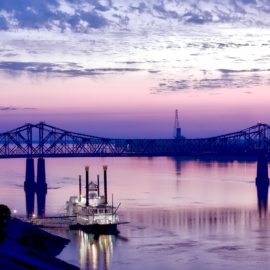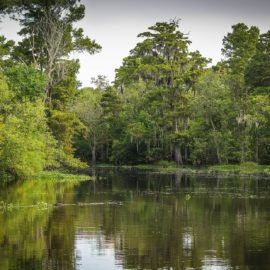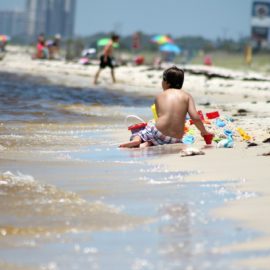
Neptune Pass is blocking the Mississippi and a fix is coming.
Near the mouth of the Mississippi River, there are few large swamp forests. Coastal erosion has also made it harder for vegetation to thrive. But in an offshoot of the river deep in Plaquemines Parish, a young grove of willow trees has begun to grow. Fields of weeds and lilies surround smaller plants nearby, and boats – long used to few barriers in this section of waterways – have had to carefully navigate around sandbars that have cropped up in recent years due to a natural diversion. The diversion, Neptune Pass, is creating new land in Breton Sound. But it’s also causing problems for the ships that sail up the river, a problem the Army Corps of Engineers hopes to solve.
nola.com
The blockage is down river by Buras and sediment is piliung up, making land!
Neptune Pass, a waterway near the mouth of the Mississippi across from Buras, has started taking in 16% of the river’s discharge, according to the Corps. Because the pass is taking in more water than sediment, more sediment is piling up on the river, forcing the Corps to dredge the area more often so ships can pass. To remedy this, the Corps has proposed making a flow control structure to limit water flow into Neptune Pass. The project would remove more than 17,000 square feet of marsh from both sides of the pass, and use 140,000 tons of stone for the closure structure to rest upon. That structure would have a notch for water, fish and small boats to pass through. The agency is accepting public comments on its plan through Oct. 16.
Ship navigation has been affected and that is the driving force for the work.
The change in river flow makes navigation more difficult because ships can’t see where new sand bars are forming, which makes travel in a nearby bay nearly impossible. However, some critics still want the project to place a higher emphasis on coastal restoration. “Accreting deltaic wetlands… provide valuable high-quality habitat for a variety of fish and wildlife including migratory waterfowl, and commercially and recreationally important fish and shellfish,” wrote Brigitte Firmin, a field supervisor for the U.S. Fish and Wildlife Service, in a letter to the Corps. In its draft Environmental Impact Study on the project, the Corps acknowledges that it will ultimately be sacrificing new fish and wildlife habitat to avoid potentially spending tens of millions of dollars in increased dredging efforts. Land restoration advocates say that, if they’re given the opportunity to work with the Corps and conduct more research, they could come up with an alternative to the current proposal. “We’re trying to get the Corps to think about building (the structure) in such a way that it can capture more sediment and get it out of the system here, versus having to dredge higher up in the river,” Pontchartrain Conservancy Director Michael Hopkins said. “I think could be a strategic advantage.”
Neptune Pass started out small with under 10% of the river feed but has grown.
In 2016, Neptune Pass was a small channel of the Mississippi, taking in 6% of its discharge. Since then, the pass has gradually taken in more of the river’s flow, washing away the land that was in it before. And now, more water and sediment is flowing into nearby Quarantine Bay and Bay Denesse. The U.S. Fish and Wildlife Service estimates that, if the flow control structure isn’t built, Quarantine Bay will build 5 acres of land a year, and Bay Denesse will build 9 acres of land a year. If the structure is built, all land growth from Neptune Pass will stop. The Corps plans to curb the river’s discharge to 2016 levels. But not everyone is convinced that the land that has built up over time is bad for the area. “There’s a lot more science that needs to happen.” Amanda Moore, the Gulf Program Director for the National Wildlife Federation said. “The Corps says that it’s a sediment-lean area of the river. That is perhaps downplaying the flow coming through and how it’s building land.”
Efforts are being made to build land and this is land being built. The problem is it being built in the wrong area.
Along Neptune Pass, long leaf pine grass and duckweed are growing from the higher volume of sediment that’s been deposited. These plants have also made way for willow trees to grow within the past two years, according to Moore. The plant diversity provides food and habitat for birds and fish. “It’s an opportunity for us to manage for both navigation and restoration,” Moore added. “If we do the studies and we don’t do the knee jerk reaction, it’s an opportunity for us to think about it in a different way.” Meanwhile, Ryan Lambert, founder of Cajun Fishing Adventures, doesn’t want Neptune Pass to close. On a recent tour of the area, he waved gleefully at the new land growth, and said he’s seen the landscape change on a weekly basis. Lambert thinks the pass is taking up to 60,000 cubic feet per second of water from the Mississippi, and hopes the corps will still allow a high volume of water to pass through. Bay Denesse, which he’s sailed through previously, is no longer traversable by boat because it’s been filled in by sediment, Lambert said. Neptune Pass has even created a sand bar in Quarantine Bay. Lambert said that this natural diversion could be a solution to coastal restoration, and help protect Louisiana from future storms. “How much does it cost every homeowner for the increase in flood insurance this year? Mine was 3000, ” Lambert said. “How does that add up? Sooner or later the Corps has got to get it in their mandate that flood control navigation should be equal to and not more important than restoration.”
We need the land and we need the navigation and I hope the two and both be worked out.



